Report on Job Satisfaction: Case Study of Clara Stone at XYZ School
VerifiedAdded on 2023/06/05
|6
|1367
|454
Report
AI Summary
This report presents a case study analysis of Clara Stone's job satisfaction within an organization. It explores the factors contributing to her job dissatisfaction, including inadequate remuneration and increased workload. The report examines the influence of job characteristics, organizational commitment, and the lack of extrinsic motivation on Clara's experience. It also provides a reflective analysis, suggesting that the organization should recognize employee potential and offer both intrinsic and extrinsic motivation. The report concludes that job satisfaction is crucial for both employees and the organization, as it impacts stress levels, work-life balance, and employee attrition. The case study highlights the importance of fair compensation, manageable workloads, and organizational support in fostering a positive work environment.

Running head: WORK & ORGANIZATION
Work & Organization
Name of the Student
Name of the University
Author note
Work & Organization
Name of the Student
Name of the University
Author note
Paraphrase This Document
Need a fresh take? Get an instant paraphrase of this document with our AI Paraphraser
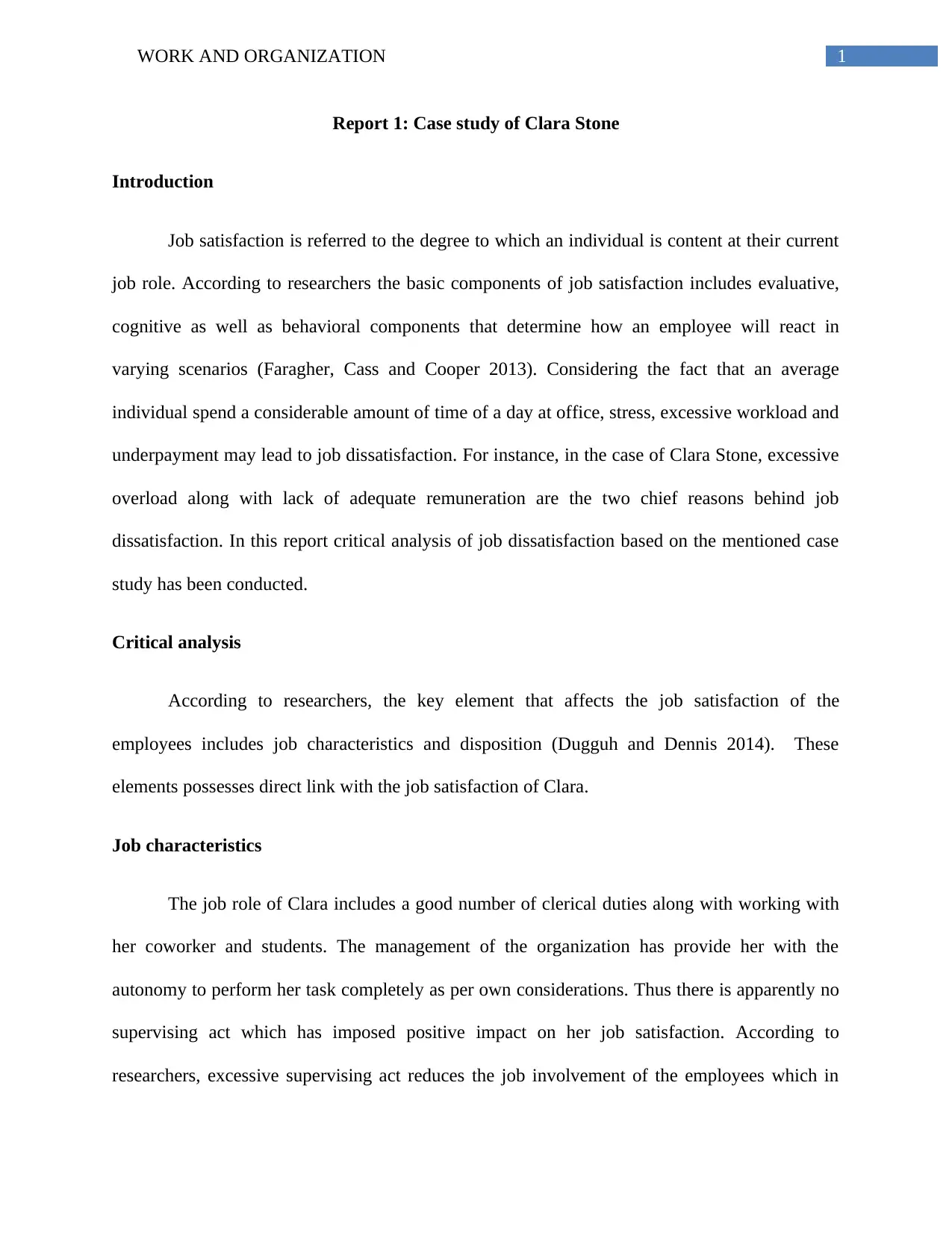
1WORK AND ORGANIZATION
Report 1: Case study of Clara Stone
Introduction
Job satisfaction is referred to the degree to which an individual is content at their current
job role. According to researchers the basic components of job satisfaction includes evaluative,
cognitive as well as behavioral components that determine how an employee will react in
varying scenarios (Faragher, Cass and Cooper 2013). Considering the fact that an average
individual spend a considerable amount of time of a day at office, stress, excessive workload and
underpayment may lead to job dissatisfaction. For instance, in the case of Clara Stone, excessive
overload along with lack of adequate remuneration are the two chief reasons behind job
dissatisfaction. In this report critical analysis of job dissatisfaction based on the mentioned case
study has been conducted.
Critical analysis
According to researchers, the key element that affects the job satisfaction of the
employees includes job characteristics and disposition (Dugguh and Dennis 2014). These
elements possesses direct link with the job satisfaction of Clara.
Job characteristics
The job role of Clara includes a good number of clerical duties along with working with
her coworker and students. The management of the organization has provide her with the
autonomy to perform her task completely as per own considerations. Thus there is apparently no
supervising act which has imposed positive impact on her job satisfaction. According to
researchers, excessive supervising act reduces the job involvement of the employees which in
Report 1: Case study of Clara Stone
Introduction
Job satisfaction is referred to the degree to which an individual is content at their current
job role. According to researchers the basic components of job satisfaction includes evaluative,
cognitive as well as behavioral components that determine how an employee will react in
varying scenarios (Faragher, Cass and Cooper 2013). Considering the fact that an average
individual spend a considerable amount of time of a day at office, stress, excessive workload and
underpayment may lead to job dissatisfaction. For instance, in the case of Clara Stone, excessive
overload along with lack of adequate remuneration are the two chief reasons behind job
dissatisfaction. In this report critical analysis of job dissatisfaction based on the mentioned case
study has been conducted.
Critical analysis
According to researchers, the key element that affects the job satisfaction of the
employees includes job characteristics and disposition (Dugguh and Dennis 2014). These
elements possesses direct link with the job satisfaction of Clara.
Job characteristics
The job role of Clara includes a good number of clerical duties along with working with
her coworker and students. The management of the organization has provide her with the
autonomy to perform her task completely as per own considerations. Thus there is apparently no
supervising act which has imposed positive impact on her job satisfaction. According to
researchers, excessive supervising act reduces the job involvement of the employees which in
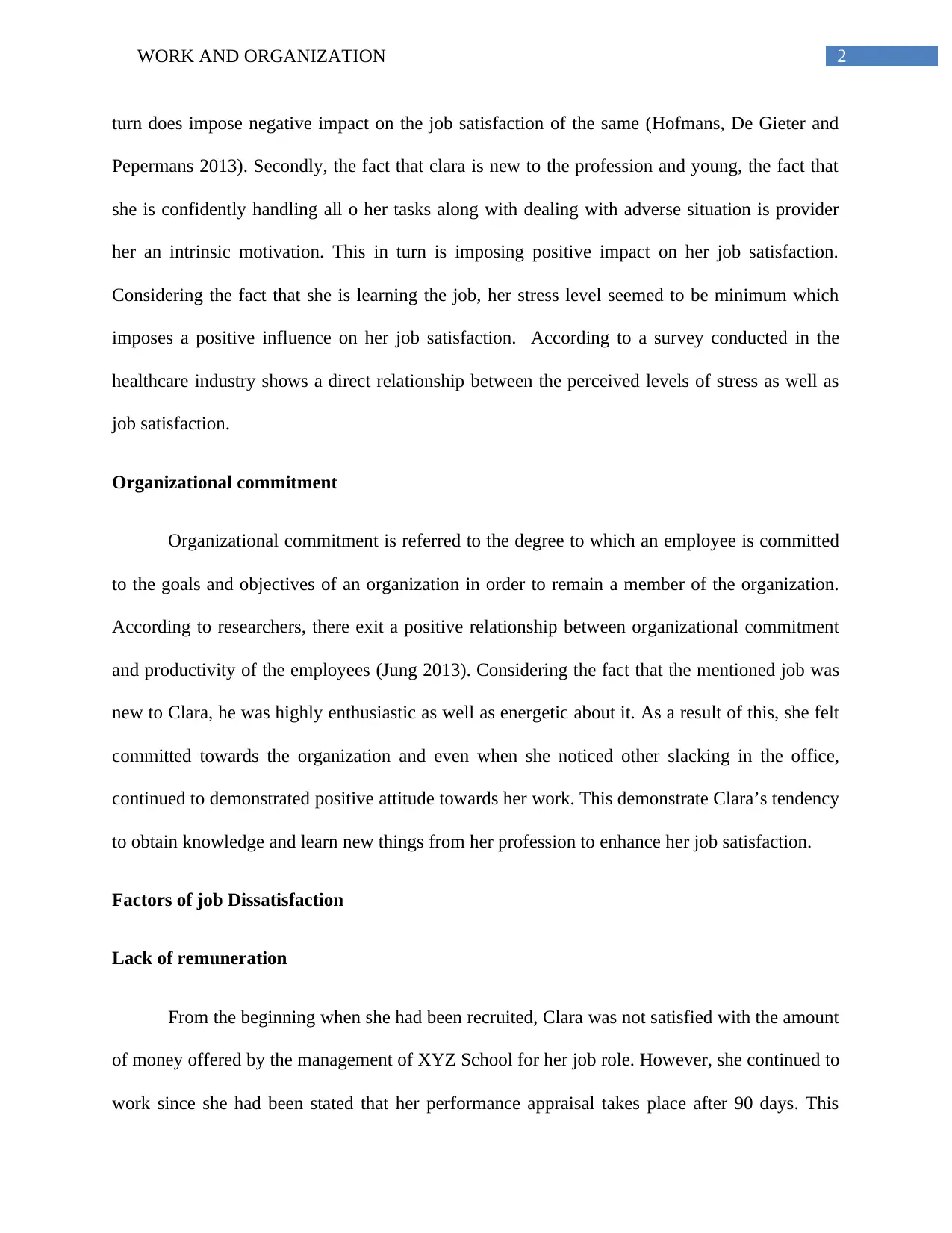
2WORK AND ORGANIZATION
turn does impose negative impact on the job satisfaction of the same (Hofmans, De Gieter and
Pepermans 2013). Secondly, the fact that clara is new to the profession and young, the fact that
she is confidently handling all o her tasks along with dealing with adverse situation is provider
her an intrinsic motivation. This in turn is imposing positive impact on her job satisfaction.
Considering the fact that she is learning the job, her stress level seemed to be minimum which
imposes a positive influence on her job satisfaction. According to a survey conducted in the
healthcare industry shows a direct relationship between the perceived levels of stress as well as
job satisfaction.
Organizational commitment
Organizational commitment is referred to the degree to which an employee is committed
to the goals and objectives of an organization in order to remain a member of the organization.
According to researchers, there exit a positive relationship between organizational commitment
and productivity of the employees (Jung 2013). Considering the fact that the mentioned job was
new to Clara, he was highly enthusiastic as well as energetic about it. As a result of this, she felt
committed towards the organization and even when she noticed other slacking in the office,
continued to demonstrated positive attitude towards her work. This demonstrate Clara’s tendency
to obtain knowledge and learn new things from her profession to enhance her job satisfaction.
Factors of job Dissatisfaction
Lack of remuneration
From the beginning when she had been recruited, Clara was not satisfied with the amount
of money offered by the management of XYZ School for her job role. However, she continued to
work since she had been stated that her performance appraisal takes place after 90 days. This
turn does impose negative impact on the job satisfaction of the same (Hofmans, De Gieter and
Pepermans 2013). Secondly, the fact that clara is new to the profession and young, the fact that
she is confidently handling all o her tasks along with dealing with adverse situation is provider
her an intrinsic motivation. This in turn is imposing positive impact on her job satisfaction.
Considering the fact that she is learning the job, her stress level seemed to be minimum which
imposes a positive influence on her job satisfaction. According to a survey conducted in the
healthcare industry shows a direct relationship between the perceived levels of stress as well as
job satisfaction.
Organizational commitment
Organizational commitment is referred to the degree to which an employee is committed
to the goals and objectives of an organization in order to remain a member of the organization.
According to researchers, there exit a positive relationship between organizational commitment
and productivity of the employees (Jung 2013). Considering the fact that the mentioned job was
new to Clara, he was highly enthusiastic as well as energetic about it. As a result of this, she felt
committed towards the organization and even when she noticed other slacking in the office,
continued to demonstrated positive attitude towards her work. This demonstrate Clara’s tendency
to obtain knowledge and learn new things from her profession to enhance her job satisfaction.
Factors of job Dissatisfaction
Lack of remuneration
From the beginning when she had been recruited, Clara was not satisfied with the amount
of money offered by the management of XYZ School for her job role. However, she continued to
work since she had been stated that her performance appraisal takes place after 90 days. This
⊘ This is a preview!⊘
Do you want full access?
Subscribe today to unlock all pages.

Trusted by 1+ million students worldwide
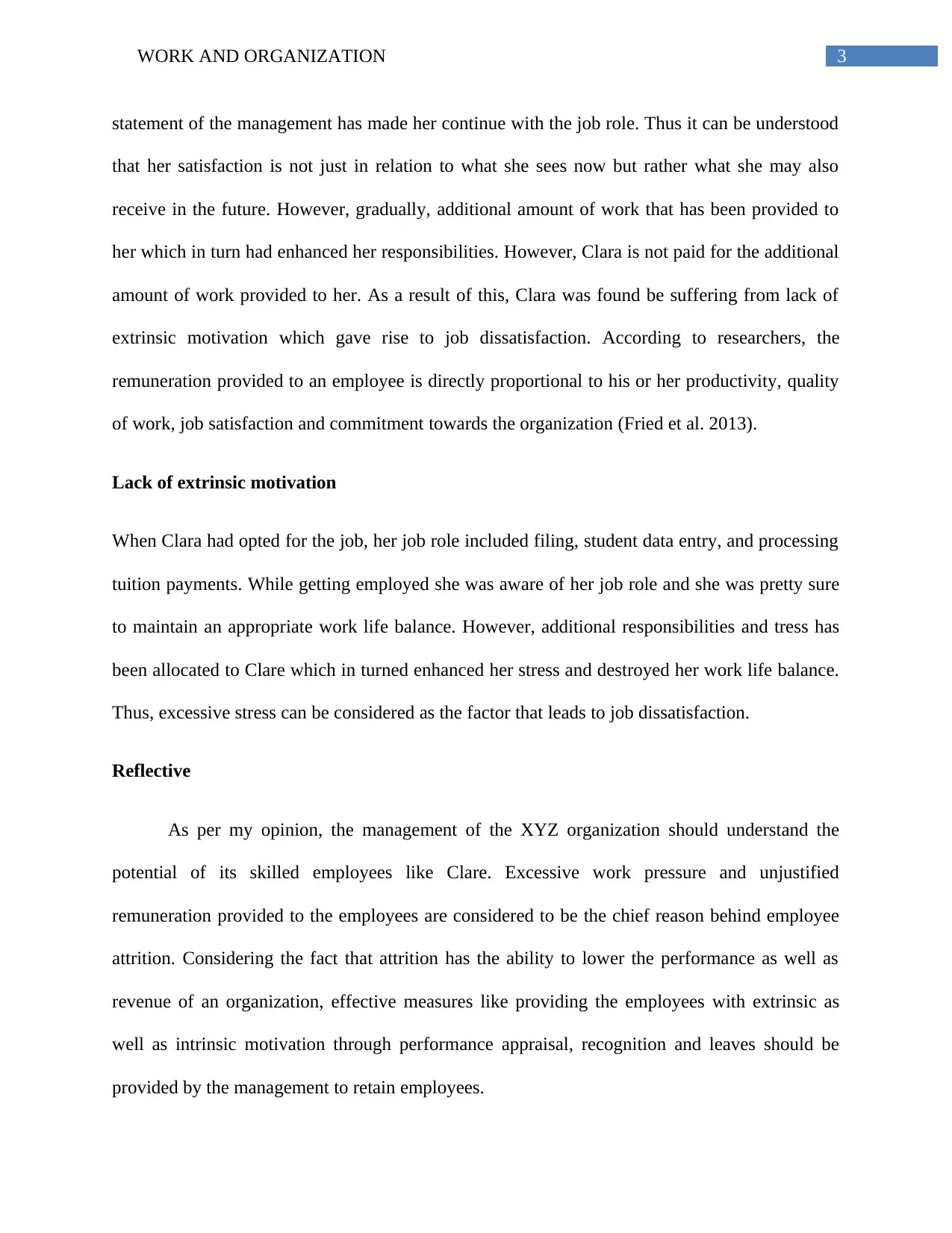
3WORK AND ORGANIZATION
statement of the management has made her continue with the job role. Thus it can be understood
that her satisfaction is not just in relation to what she sees now but rather what she may also
receive in the future. However, gradually, additional amount of work that has been provided to
her which in turn had enhanced her responsibilities. However, Clara is not paid for the additional
amount of work provided to her. As a result of this, Clara was found be suffering from lack of
extrinsic motivation which gave rise to job dissatisfaction. According to researchers, the
remuneration provided to an employee is directly proportional to his or her productivity, quality
of work, job satisfaction and commitment towards the organization (Fried et al. 2013).
Lack of extrinsic motivation
When Clara had opted for the job, her job role included filing, student data entry, and processing
tuition payments. While getting employed she was aware of her job role and she was pretty sure
to maintain an appropriate work life balance. However, additional responsibilities and tress has
been allocated to Clare which in turned enhanced her stress and destroyed her work life balance.
Thus, excessive stress can be considered as the factor that leads to job dissatisfaction.
Reflective
As per my opinion, the management of the XYZ organization should understand the
potential of its skilled employees like Clare. Excessive work pressure and unjustified
remuneration provided to the employees are considered to be the chief reason behind employee
attrition. Considering the fact that attrition has the ability to lower the performance as well as
revenue of an organization, effective measures like providing the employees with extrinsic as
well as intrinsic motivation through performance appraisal, recognition and leaves should be
provided by the management to retain employees.
statement of the management has made her continue with the job role. Thus it can be understood
that her satisfaction is not just in relation to what she sees now but rather what she may also
receive in the future. However, gradually, additional amount of work that has been provided to
her which in turn had enhanced her responsibilities. However, Clara is not paid for the additional
amount of work provided to her. As a result of this, Clara was found be suffering from lack of
extrinsic motivation which gave rise to job dissatisfaction. According to researchers, the
remuneration provided to an employee is directly proportional to his or her productivity, quality
of work, job satisfaction and commitment towards the organization (Fried et al. 2013).
Lack of extrinsic motivation
When Clara had opted for the job, her job role included filing, student data entry, and processing
tuition payments. While getting employed she was aware of her job role and she was pretty sure
to maintain an appropriate work life balance. However, additional responsibilities and tress has
been allocated to Clare which in turned enhanced her stress and destroyed her work life balance.
Thus, excessive stress can be considered as the factor that leads to job dissatisfaction.
Reflective
As per my opinion, the management of the XYZ organization should understand the
potential of its skilled employees like Clare. Excessive work pressure and unjustified
remuneration provided to the employees are considered to be the chief reason behind employee
attrition. Considering the fact that attrition has the ability to lower the performance as well as
revenue of an organization, effective measures like providing the employees with extrinsic as
well as intrinsic motivation through performance appraisal, recognition and leaves should be
provided by the management to retain employees.
Paraphrase This Document
Need a fresh take? Get an instant paraphrase of this document with our AI Paraphraser
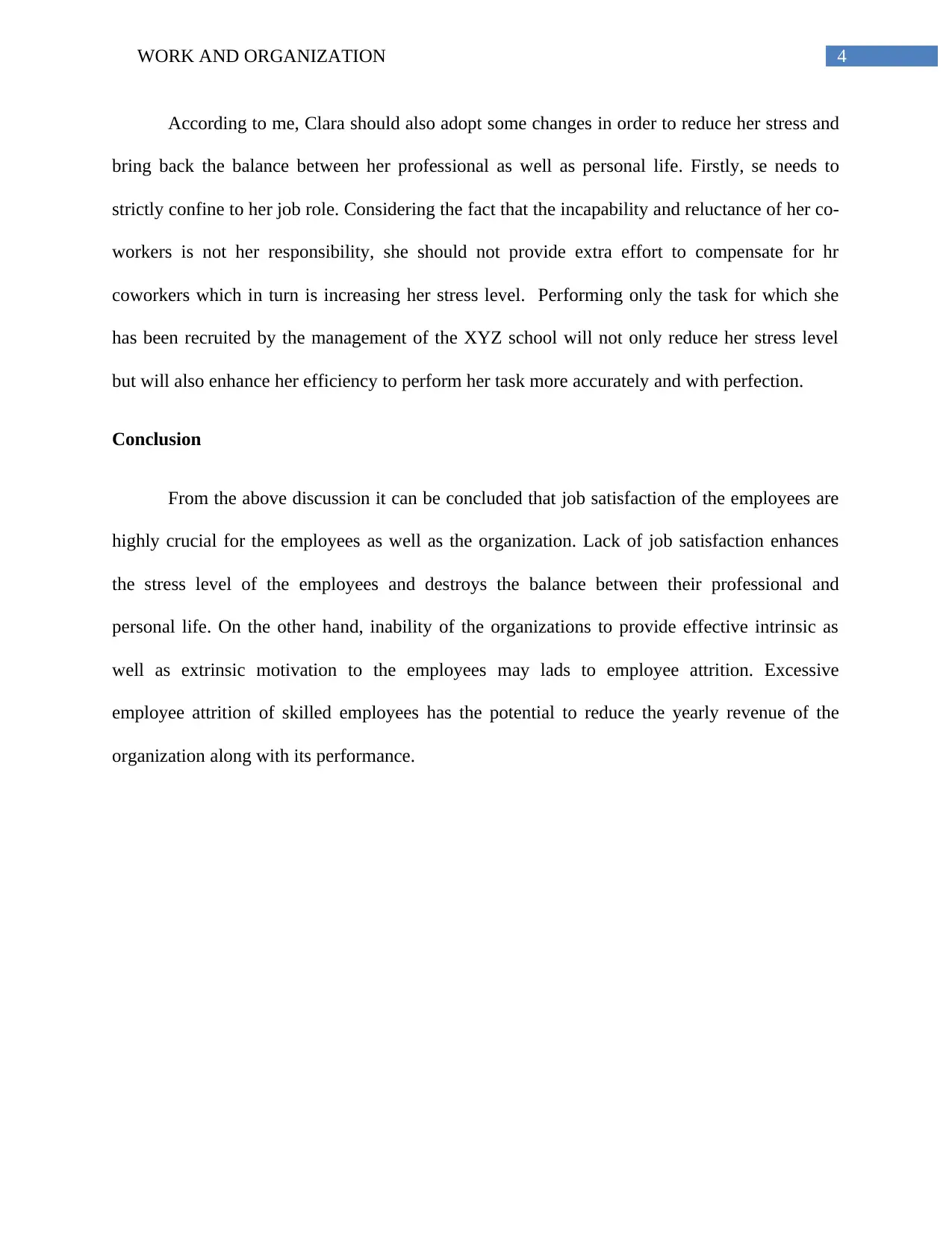
4WORK AND ORGANIZATION
According to me, Clara should also adopt some changes in order to reduce her stress and
bring back the balance between her professional as well as personal life. Firstly, se needs to
strictly confine to her job role. Considering the fact that the incapability and reluctance of her co-
workers is not her responsibility, she should not provide extra effort to compensate for hr
coworkers which in turn is increasing her stress level. Performing only the task for which she
has been recruited by the management of the XYZ school will not only reduce her stress level
but will also enhance her efficiency to perform her task more accurately and with perfection.
Conclusion
From the above discussion it can be concluded that job satisfaction of the employees are
highly crucial for the employees as well as the organization. Lack of job satisfaction enhances
the stress level of the employees and destroys the balance between their professional and
personal life. On the other hand, inability of the organizations to provide effective intrinsic as
well as extrinsic motivation to the employees may lads to employee attrition. Excessive
employee attrition of skilled employees has the potential to reduce the yearly revenue of the
organization along with its performance.
According to me, Clara should also adopt some changes in order to reduce her stress and
bring back the balance between her professional as well as personal life. Firstly, se needs to
strictly confine to her job role. Considering the fact that the incapability and reluctance of her co-
workers is not her responsibility, she should not provide extra effort to compensate for hr
coworkers which in turn is increasing her stress level. Performing only the task for which she
has been recruited by the management of the XYZ school will not only reduce her stress level
but will also enhance her efficiency to perform her task more accurately and with perfection.
Conclusion
From the above discussion it can be concluded that job satisfaction of the employees are
highly crucial for the employees as well as the organization. Lack of job satisfaction enhances
the stress level of the employees and destroys the balance between their professional and
personal life. On the other hand, inability of the organizations to provide effective intrinsic as
well as extrinsic motivation to the employees may lads to employee attrition. Excessive
employee attrition of skilled employees has the potential to reduce the yearly revenue of the
organization along with its performance.
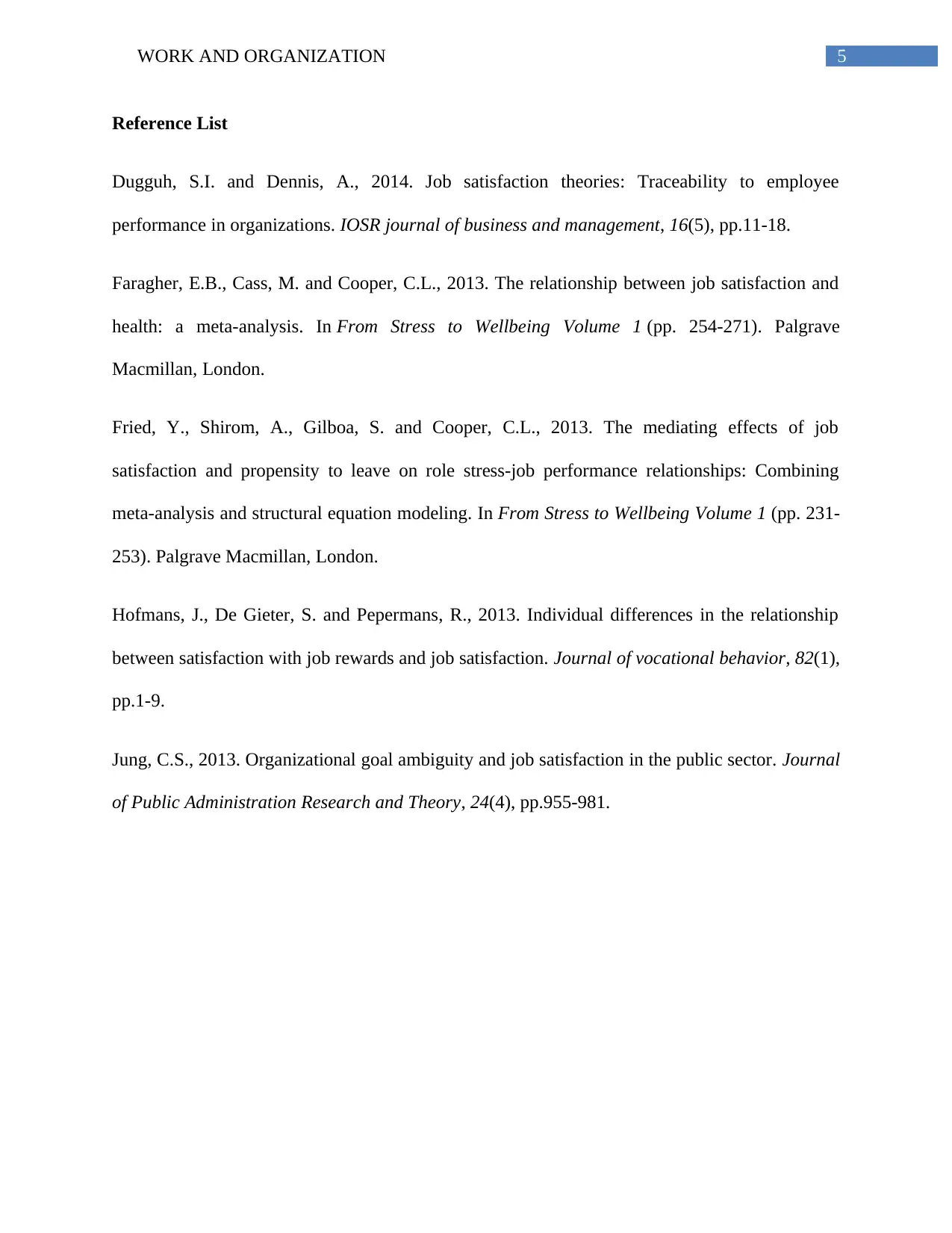
5WORK AND ORGANIZATION
Reference List
Dugguh, S.I. and Dennis, A., 2014. Job satisfaction theories: Traceability to employee
performance in organizations. IOSR journal of business and management, 16(5), pp.11-18.
Faragher, E.B., Cass, M. and Cooper, C.L., 2013. The relationship between job satisfaction and
health: a meta-analysis. In From Stress to Wellbeing Volume 1 (pp. 254-271). Palgrave
Macmillan, London.
Fried, Y., Shirom, A., Gilboa, S. and Cooper, C.L., 2013. The mediating effects of job
satisfaction and propensity to leave on role stress-job performance relationships: Combining
meta-analysis and structural equation modeling. In From Stress to Wellbeing Volume 1 (pp. 231-
253). Palgrave Macmillan, London.
Hofmans, J., De Gieter, S. and Pepermans, R., 2013. Individual differences in the relationship
between satisfaction with job rewards and job satisfaction. Journal of vocational behavior, 82(1),
pp.1-9.
Jung, C.S., 2013. Organizational goal ambiguity and job satisfaction in the public sector. Journal
of Public Administration Research and Theory, 24(4), pp.955-981.
Reference List
Dugguh, S.I. and Dennis, A., 2014. Job satisfaction theories: Traceability to employee
performance in organizations. IOSR journal of business and management, 16(5), pp.11-18.
Faragher, E.B., Cass, M. and Cooper, C.L., 2013. The relationship between job satisfaction and
health: a meta-analysis. In From Stress to Wellbeing Volume 1 (pp. 254-271). Palgrave
Macmillan, London.
Fried, Y., Shirom, A., Gilboa, S. and Cooper, C.L., 2013. The mediating effects of job
satisfaction and propensity to leave on role stress-job performance relationships: Combining
meta-analysis and structural equation modeling. In From Stress to Wellbeing Volume 1 (pp. 231-
253). Palgrave Macmillan, London.
Hofmans, J., De Gieter, S. and Pepermans, R., 2013. Individual differences in the relationship
between satisfaction with job rewards and job satisfaction. Journal of vocational behavior, 82(1),
pp.1-9.
Jung, C.S., 2013. Organizational goal ambiguity and job satisfaction in the public sector. Journal
of Public Administration Research and Theory, 24(4), pp.955-981.
⊘ This is a preview!⊘
Do you want full access?
Subscribe today to unlock all pages.

Trusted by 1+ million students worldwide
1 out of 6
Related Documents
Your All-in-One AI-Powered Toolkit for Academic Success.
+13062052269
info@desklib.com
Available 24*7 on WhatsApp / Email
![[object Object]](/_next/static/media/star-bottom.7253800d.svg)
Unlock your academic potential
Copyright © 2020–2025 A2Z Services. All Rights Reserved. Developed and managed by ZUCOL.





